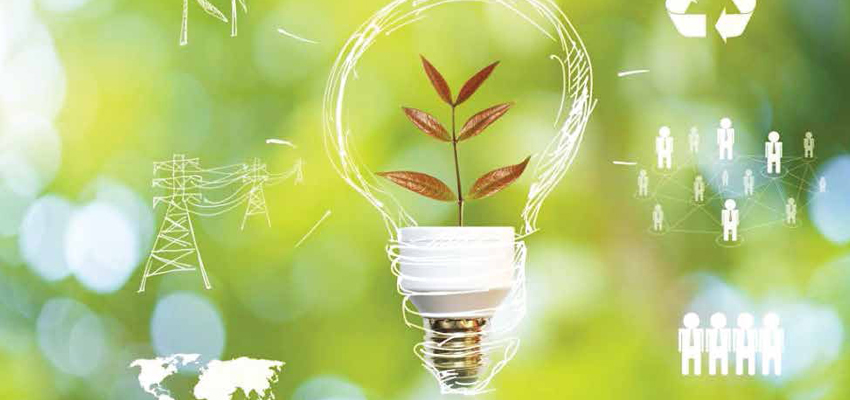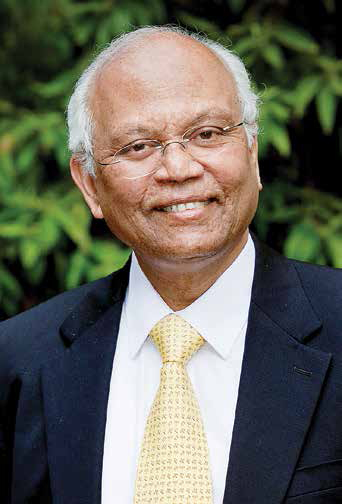Green Energy for a Sustainable Future

India is one of the most energy-consuming nations in the world. Oil forms the bulk of India’s imports, affecting our country’s balance of payments as well as increasing dependence on other countries. This is why the need for green energy alternatives has never been more prominent. At a fireside chat at the Asia Economic Dialogue (AED) 2022 hosted by the Pune International Centre, Dr R A Mashelkar, former Director-General of the Council of Scientific and Industrial Research (CSIR), talks with Mukesh Ambani, Chairman and Managing Director of Reliance Industries, India’s largest private-sector organisation, on the topic of Green Energy for a Sustainable Future. Corporate Citizen brings you the riveting conversation
"The climate crisis is essentially an energy crisis. The excessive use of fossil fuels in the past 200 years has greatly endangered the fragile ecology of the planet."
-Mukesh Ambani,
Dr R A Mashelkar: Reliance operates across energy, materials, retail, digital services and media and entertainment sectors. I have an abundance of personal affection and personal admiration for Mukesh Bhai. Our theme this year is Resilient Growth in the Post-pandemic World. Before we begin our discussion on ‘Green energy for a sustainable future’, may I ask you about your thoughts on Asia’s future and the place of India in particular?
 Mukesh Ambani
Mukesh Ambani
Mukesh Ambani: It is becoming more obvious with each passing year, that the 21st century will be Asia’s century. The centre of gravity of Asia’s economy has clearly shifted to Asia. From the 1st to the 18th century, Asia was leading the world in global GDP. After suffering a retreat in the last two centuries, Asia is now making a strong comeback. In 2020, Asia’s GDP has overtaken the GDP of the rest of the world combined. By 2030, the Asian region is expected to contribute roughly 60% of global growth. We should also remember that Asia accounts for 60% of the world’s population. More Asians will join the middle-class in the next two decades than the combined population of all other countries. Which means, Asia is leading the march towards a more inclusive global economy. The mismatch between demography and development is closing. All this goes to show that a resurgent Asia can contribute to a more equal world. This is a most welcome change. This trend is also reinforced by the fact that India is likely to overtake Japan as Asia’s second-largest economy and the world’s third-largest economy by 2030. I am very confident that India’s growth soon will be as exciting if not more than that of China in the coming decades. This is India’s time.
Q: Let me now turn to our topic “Green energy for a sustainable world”. Let me begin by asking you “why green energy”?
To my mind, the answer is very simple. All of us as humans have only one planet. There is no planet B. The only planet in the entire universe which is home to human life and countless other life forms is planet Earth, and our planet is facing an existential crisis because of climate change. The climate crisis is essentially an energy crisis. The excessive use of fossil fuels in the past 200 years has greatly endangered the fragile ecology of the planet.
It also brought prosperity to a large part of the global community but this prosperity has been at the cost of the planet’s environment and eco-system and hence, it is unsustainable. Climate change is the biggest threat today to mankind. It is an even graver threat to plants and species, which are ending our planetary relatedness. Human beings, plants and animals aren’t adversaries competing for space on this planet. They are linked by co-operation and symbiosis. As a lover of wildlife and nature myself, and as someone who likes to spend time in nature parks, wildlife sanctuaries, I can tell you that we have a responsibility to conserve all these precious gifts of mother nature and pass them on to our future generations. So, the transition from old energy to new, green and clean energy is not an option, it is an urgent requirement. Our very survival depends on how quickly we embrace planet-friendly renewables such as wind and solar energy.
Energy transition will also determine the geopolitical transition in the 21st century. When wood was replaced by coal, Europe overtook India and China to emerge the world leader. Similarly, with the emergence of oil, the US and West Asia outgrew others. When India becomes not only self-sufficient in green and clean energy, but also a large exporter, it will help India emerge as a global power. India will demonstrate that prosperity for all people and prosperity for our planet is not mutually contradictory. This transition will have other benefits as well, such as a huge number of green jobs. It can also mean massive foreign exchange savings since energy and electronics are today India’s biggest imports. Finally, green and clean energy ensures better health and better quality of life for everyone on the planet. Therefore, I believe that the transition to new energy will indeed lead to a new earth-friendly industrial revolution.
"I foresee that at least 20 to 30 new Indian companies in the energy and tech space will grow as big as Reliance if not bigger in the next 20-30 years"

Q: Can you please explain your grand vision?
If we see the trajectory of the first three industrial revolutions, we find that they basically disrupted the harmony between human beings and nature. The economic growth in the past few centuries was premised on the principle of control and exploitation of nature and natural resources.
In contrast, the transition to green and clean energy represents a disruption of a reverse kind. I think we are now beginning to learn from Mother Nature. Our new energy technologies are mimicking Mother Nature in so far as converting sunshine and hydrogen into water and electricity. Mother Nature has also created a virtuous carbon cycle in which, carbon is not a liability but an asset. In due course of time, carbon capture, utilisation and storage technologies will attain scale and help reduce the carbon growth in the atmosphere. There is another way in which new energy represents an earth-friendly industrial revolution. In the era of fossil fuels, industrial activities are highly centralised. This is because coal and oil are centralised in their origin and have to be transported at large distances. In contrast, in the coming era of abundant and affordable clean and green energy, with utility scaled battery storage, it is possible to envision that every house, every farm, factory, and every habitat would free itself from the grid by generating its own power. The world is also developing technologies that uses less land to produce all that we need. You always say more from less, and that is what is happening at a global scale all around us that means we can earmark more land for forests which also acts as a natural carbon sequester. This is what I mean by the need to transition from the industrial revolution to the ecological revolution or the earth-friendly industrial revolution. The vision of an earth-friendly industrial revolution has prompted Reliance to adopt care for the planet along with “care for the people” as a guiding principle of everything we do in all our businesses and philanthropic activities.
Q: You have often talked about 3Ds, namely, Digitalisation, Decentralisation and Decarbonisation. You have also talked about your dream of India not as a follower, but as a leader. Can India emerge as a global new-energy leader?
I have absolutely no doubt that India can and will emerge as a global new energy leader. We were among the first in the world where our renewable energy minister announced a Hydrogen policy. While the world is still grappling with this, we have put our vision of exporting green energy out of India on the table. Our Prime Minister believes in ensuring that this next generation of Indians will not only be self-sufficient and Atmanirbhar in their energy, but India can also export green energy. And my optimism and confidence really stems from three further reasons.
The first is that India is a country full of entrepreneurial spirit, innovation, and youth. Secondly, we now have proactive and forward-looking policy support and action from our government, both at the central and state level. Thirdly, our entrepreneurs now have assured financing options. I have immense faith in the abilities of our young entrepreneurs. They are highly ambitious and highly talented. I am fortunate to see a lot of them in action all around.
I foresee that at least 20 to 30 new Indian companies in the energy and tech space will grow as big as Reliance if not bigger in the next 20-30 years. Let me put this in perspective. It took Reliance about 15 years to become a billion dollar company. 30 years to become a $10 billion company; 35 years to become a $100 billion company and 38 years to touch $200 billion. I have no doubt that the next generation of Indian entrepreneurs will achieve this in half the time. What this also means is that India’s community of entrepreneurs will become broader and wealth creation will also become more inclusive. This makes India a more equal nation. Let me make another prediction. India’s technology and digital exports have risen to $4150 billion from less than $10 billion 20 years go. Similarly, India’s clean and green energy exports in the next 20 years also have the potential to touch half a trillion dollars in exports.
In the last 20 years, we were known for India’s emergence as an IT superpower. In the next 20 years, I believe, we will be a superpower in energy and life sciences. What is commendable is that the new energy businesses in India are standing on their own two feet with their own entrepreneurship and with very little support of any government subsidies. Technological progress will make energy affordable on the basis of commercial viability and it will be technology, entrepreneurial spirit, and the new business model which gives values to customers which will drive business and not government subsidies, and that’s encouraging about the new energy opportunities that I see.
Q: There is always a concern that new technology must be backed by policy and investments. Do you foresee any hurdles in that regard?

Let me share with you my perspective. Today, India is one of the most attractive opportunities for renewable energy investment anywhere in the world. As far as policy is considered, I believe that the Government of India is extremely committed to promoting new energy. Among all other countries in the world, we have been proactive as in the past and we are at the bleeding edge of policy development and all of these policies are transparent and pro-consumer, and the commitment begins at the highest level from our honourable Prime Minister Shri Narendra Modi himself, right from his days in Gujarat. He is a big proponent of renewable energy. The government is proactive in meeting the financing needs of the new energy sector. The recent announcement in the Union budget about the launch of sovereign green bonds is a step in that direction.
India achieved its target of 40% power generation of renewables of the target that it is set for 2030 in 2021 itself and I believe, we will be ahead of this target. India aims to achieve 5000 Megawatt of renewable power capacity which I am sure we will meet. Right now on the basis of what we see, I am very optimistic.
Q: You always tell us about speed, scale and sustainability, in which Reliance is a leader. Coming to India, what are the other factors that will favour India’s transition to new energy?
India’s progress is unstoppable. We will become a $5 trillion economy, we will become a $10 trillion economy, and we can only argue whether it will happen in 2025 or 2027 or so on. When that happens, the quality of life of every Indian has to improve. Today, our per capita energy consumption is one-third of demand. I think for the quality of life of all Indians to improve, India’s own domestic demand for energy will be enormous. Indians are already known to have one of the most eco-friendly and sustainable lifestyles. Our annual carbon emission is about one-fifth of the average Chinese or one-eighth of the average American. Even if it increases, we will be able to meet it. The average Indian’s carbon emissions are less than half of the world average. Indians won’t have to make too many lifestyle changes to be carbon neutral. India’s per capita income is about $2000 compared to Europe’s $38,000. I believe we will progressively reach $10,000 per capita in the next 15-20 years, and this will increase the energy demand, and at the same time, we will be able to meet the incremental energy demand at affordable rates, because of the progress which we are making in technology, and because of the abundance of resources that nature has blessed us with.
I believe India will be among the fastestgrowing large economies, and our energy needs are only going to double in the next couple of decades. India will overtake the EU as the world’s third-largest economy, in my view, sometime around 2030-32. India has to address its triple challenges. One, India must increase energy output to drive double-digit GDP growth. Second, India must increase its share of green and clean energy in this enhanced output, and third, India must achieve the goal of self-reliance or Aatmanirbhar Bharat, in pursuing these challenges. This cannot happen overnight. For the next two or three decades, India’s dependence on coal and imported oil will continue, but we must have a plan to eliminate that in the next two or three decades. Hence, in the near future, we will have to follow low carbon strategies of development. An affordable and abundant supply of clean energy will enable every Indian and improve their standard of living without disturbing the ecological balance. This generation has the responsibility to put successive generations on a path whereby we remain perpetually clean. We have the responsibility of being the transitional generation.